Learning by Doing: Myriad Mirrors
Reflections on a Development Apprentice’s Journey
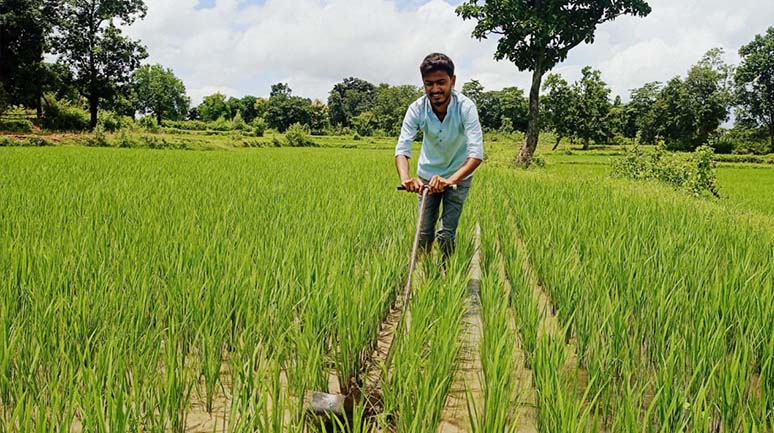
Changing one’s mind is not a weakness. In fact, it is a strength because one leaves behind one’s old beliefs and seeks the truth

Removing the weeds in a paddy field using a conoweeder. This work is traditionally performed manually by women—a back-breaking task! | Picture Courtesy: Suraj Sahu
Working with an NGO is not an easy decision to make, especially if your friends and classmates are climbing the corporate ladder, preparing for GRE and gallivanting across the globe. Before taking the plunge, I asked myself a simple question, “How much am I willing to sacrifice? PS3 games, international travel courtesy a multinational company, basic comfort of ACs and maybe KFC chicken wings?” Some questions that arose in my mind were: “What if there is no public transport? Will I get a decent room to stay with a bathroom equipped with a shower or will I be taking a bath at a well? How different is the culture of the villagers? How will I blend in?”
First steps in the development sector
In October 2020, when I joined PRADAN as a Development Apprentice in the Palkot team, Jharkhand, I saw it as a mere job that would give me basic stability in my life. This changed very soon when, during my village study, the person whose house I was living in had an accident and died in front of me despite all my efforts to take him to the hospital. The moment the bike hit him, his family accepted the fact that he would die sooner or later because they could not afford to take him to the hospital. When did death become so inevitable? Does the lack of money make one so fatalistic that one does not even try to save one’s loved one?
That incident had a huge impact on me. I asked myself, “What can I contribute? What is the solution to the misfortune the community is going through? As a development professional, will I just be overwhelmed by feelings or is there something I can do to bring about change?” I pondered over my role in this sector. In the months that followed, several incidents took place in my life that clearly told me not to underestimate the villagers or their rural practices and customs. This understanding came to me gradually as I became more and more involved in their lives and livelihoods. Here, I recount several discrete instances that stand out in my memory as events that impacted me deeply.
The meaning of development
On a cold morning in November, during my village stay, when I was in the field, I received a call from my parents and they asked me what I was doing right then. I said, “Main bakri chara raha hun (I am grazing goats).” Distressed, they asked me why I was doing this. I asked the same question of myself throughout that day. Why do these people put so much effort in rearing these goats if the goats are not a source of regular income? I was yet to understand then, that a goat is ‘like an ATM’ for them.
During those initial days, I believed that if I am in the village for development work, I should be introducing machinery for agriculture practices, giving trainings or doing something like that. When I think about it now, I realize how important it is to know what villagers considered was development for them, not what development meant to me. If a market is 5 km away from the village, it may be an issue for me; however, did this create difficulties for the villagers or did this distance mean nothing to them? Why do I need to bring the market closer if they do not want it? I pondered on these questions while I talked to the villagers.
From the beginning, I disliked the idea of holding a gram sabha (village meeting) below a tree, sitting on a plastic sheet. If there are community centres in every village, why don’t the villagers meet there? One day, I attended a gram sabha held in a community centre. What I saw there was revealing. The men sat on chairs and the women on the floor. The difference was so stark I realized then that development doesn’t necessarily mean big buildings and beautiful infrastructure, it is something different, something beyond the outer trappings.
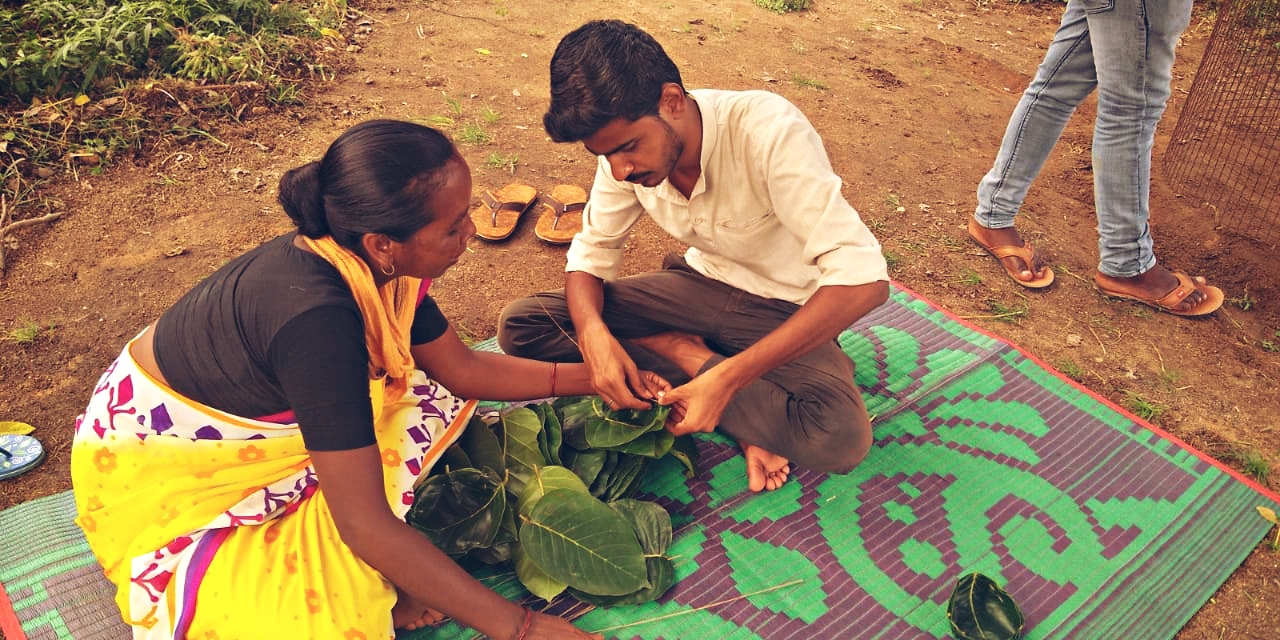
Nilmani didi of Sakea village teaching me how to stitch Siali leaves to make leaf plates | Picture Courtesy: Nidhi Kumari
Understanding and accepting customs and culture
Initially, the culture of the community I was working with, was new and struck me as somewhat strange. The villagers consumed different kinds of meat, and drinking alcohol was common during celebrations and social gatherings. Men, women, elders all drink together. I was not used to such a culture. I had been brought up with the belief that alcohol is not good; however, here I saw that alcohol was not a taboo. People prepared alcohol in their homes, and drank and celebrated openly.
I also observed another interesting custom when I was there. After a meal, I saw the members of my host family wash their hands in their plates. One day, when I asked them why they did this, they said this is their custom and that every family does the same. I was not convinced and I did not like it. I thought it was a practice that needs to be changed.
While I reflected on this practice one day, a memory of mine surfaced. When I was a little child, I was invited to a Brahmin Bhoj (a feast for Brahmins). The host family washed my feet on a plate and, later, had their meal from the same plate. And nobody, including me, ever questioned this custom because we had been told that is our culture. How then is the culture of these villagers wrong? Is it right to wash one’s hands or feet on a plate? No, of course not. These are ancient customs that perpetrate and continue the hierarchy of caste. Nevertheless, just because a custom is ancient, it does not have to be right or worth continuing. This thought compelled me to question the customs of my own culture, particularly the Brahmin Bhoj. By participating in the custom, I had unknowingly perpetuated the age-old, caste-based hierarchy.
However, all customs cannot be judged as wrong. Some practices are worth continuing and are valuable and some practices need to be changed. The important part is to question customs and arrive at the reason for carrying on with them through the ages. This episode gave me a perspective of their culture and made me realize that another society can live with entirely different values and culture and still function independently without perpetrating hatred towards each other.
Each and every community has some customs and practices that seems strange at first and are actually unique and beautiful. We may just take some time to realize their uniqueness. For example, I was always uncomfortable eating the small fish caught from the flooded paddy fields as their eyes remained wide open even after they are cooked. I had never eaten a fish like this. It felt that I am eating a live fish. Earlier, I used to complain to my team members that I had to eat such food in the village. Now that I find I am an integral part of this community, I have a sense of acceptance of their customs and their different food habits. I can eat snails too now! All I say is, “Arre, protein hota hai isme (Hey, this is full of protein!).”
Let’s dig a pit: Learning by doing
If I were to define my ‘Learning by Doing’ phase of DA-ship, I must elaborate through the use of the following example:
Q: Melody itni chocolatey kyo hai (Why is Melody so chocolatey?)?
A: Khao or khud jaan jao (Taste it and find out for yourself).
The villagers were engaged in mango plantation under the MGNREGA work. I was informed that on an average one person digs two pits per day. I thought that was too little for a day’s work. In my estimate, one person could dig at least five pits in one day. On my team’s suggestion, I started digging a pit myself, to check how much effort it takes. I could barely dig a pit 2.5 ft deep. I was completely exhausted and took a break. This incident and my subsequent realization changed my approach of engagement in different activities. I decided that to understand the effort an activity takes, I would do it physically myself to understand what it entails. I set out to learn by doing in all my activities, whether it is land preparation, paddy transplantation, jeevamrit formation, plantation layout, pit digging and filling, preparing a tomato nursery, SHG audit, teaching in a school or any other activity.
As an Agriculture Engineer, I have prepared the land for cultivation multiple times using a tractor-driven rotavator and leveller. When I tried to do the very same process manually with a pair of bullocks, I couldn’t stop laughing because the bulls’ tails spattered mud drops all over me. I was completely covered with mud within half-an-hour. I remember how I used to do puddling and levelling with a tractor; now, I did it with bullocks and it serves the same purpose. For my exams, I used to calculate the depth a plough would penetrate; here, I didn't have to do any calculations because my feet went deep into the mud and I could feel it for myself. I did not need a pen and paper because I was personally experiencing it because I was not using a diesel engine or machine. It was not a diesel engine that produced the power to level the field; it was me and those two beautiful creatures.
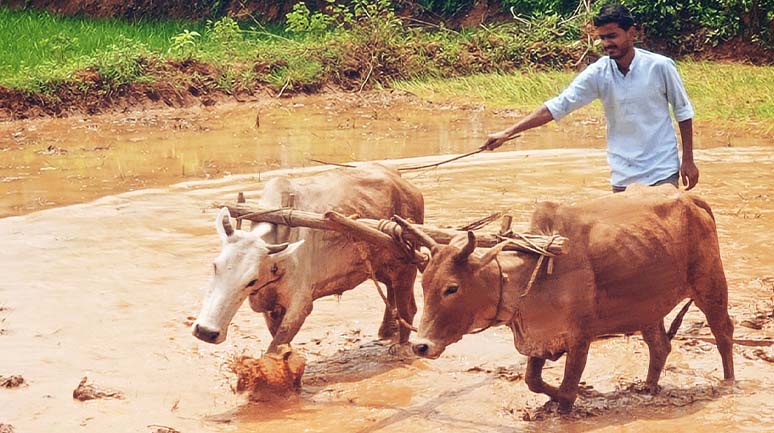
Learning by doing: Puddling and levelling with the help of bullocks, the conventional way of preparing a field | Picture Courtesy: Suraj Sahu
Many of us have seen a potter at work; yet, very few of us know how he does it. I saw a potter in the village making mud pots with accuracy and precision. I decided to give it a try. I put my hands on the potter’s wheel and distorted the shape multiple times before I suddenly got it right. Honestly, I was in seventh heaven! On conversing with the potter, I felt remorse that despite being skilled in making pots for a livelihood, he, and others like him, did not earn enough to survive.
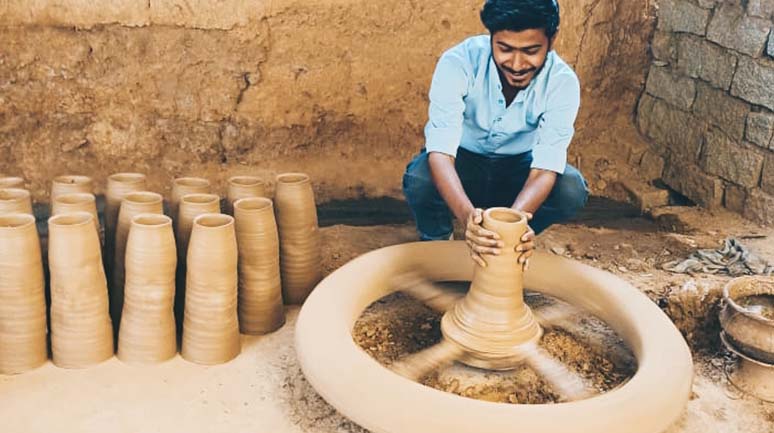
My first attempt at pottery at Laxmanda’s house in Gunderdih village | Picture Courtesy: Sarwar Quraishi
“You won’t really understand how it’s done until you do it yourself,” is my motto now. Earlier, I would close my eyes if I had to witness a goat being castrated. Now, I think, I actually need to open my eyes and see how it is done so that I understand why they do what they are doing and how it’s done. How will it impact the nature and the quality of meat of that animal? Should the goat be castrated with a blade or with a burdizzo tool? I realized that I needed to arrive at an understanding as to method is better, more hygienic. Before I prescribe it to someone, I should know why I am prescribing a particular method or tool, and why a male buck needs to be castrated.
Given a choice of receiving a gift of Rs 5000 or spending five days in the field for development work, I will certainly choose the latter. Five days spent in the field will have a long-lasting impact on me. As a young professional, the insights and learning from my field visits help me to be practical and grounded. I think that those who are in the development sector should spend time learning by doing.
Blending traditional practices and modern techniques
Cereals and pulse crops are always under high risk of bird attack. Birds inflict losses by damaging crops during the sowing, the seedling and the ripening stages, leading to considerable economic loss. Guided by our master trainer, we tried to make a crop protector using plastic bottles, a steel plate, iron nails and a wooden stick. Although it was not very pleasing aesthetically, it worked properly. The crops protector is more helpful during the ripening stage than in the initial period. In Jharkhand, the villagers intentionally set up a perch—a five-foot wooden stick in the paddy fields—to invite birds that feed on harmful insects.
In Haryana and the Punjab, various insecticides and pesticides are applied through flood water irrigation in the paddy fields. In Jharkhand, however, during the Karma festival, the villagers place a stick of the byelaw plant, which releases some liquid into the irrigation water and kills the insects. It was eye-opening for me that the community had its own traditional solutions to some of the major problems it faced. The beauty of these agricultural practices is that they evoke a sense of belonging to their roots in the villagers.
Transforming lives
What is the meaning of changing lives? Is changing one life called a change or an initiation towards change? Am I changing their lives or my own? Or maybe both? I never really understood the concept of changing, or transforming, lives or such words until I sensed that change within me. Would conducting awareness events in schools on career options impact the students? If not, for who am I doing this? For me? I started observing that it is a two-way change: I try to change the lives of the villagers and find that I am changing in the process. The acceptance of their culture, their life style, their beliefs and their happiness in the small things in their lives have become a part of me.
I now understand how the SRI method of paddy cultivation will impact a particular family and how the weekly savings of Rs 10 in the SHGs can support the family and aid their livelihoods.
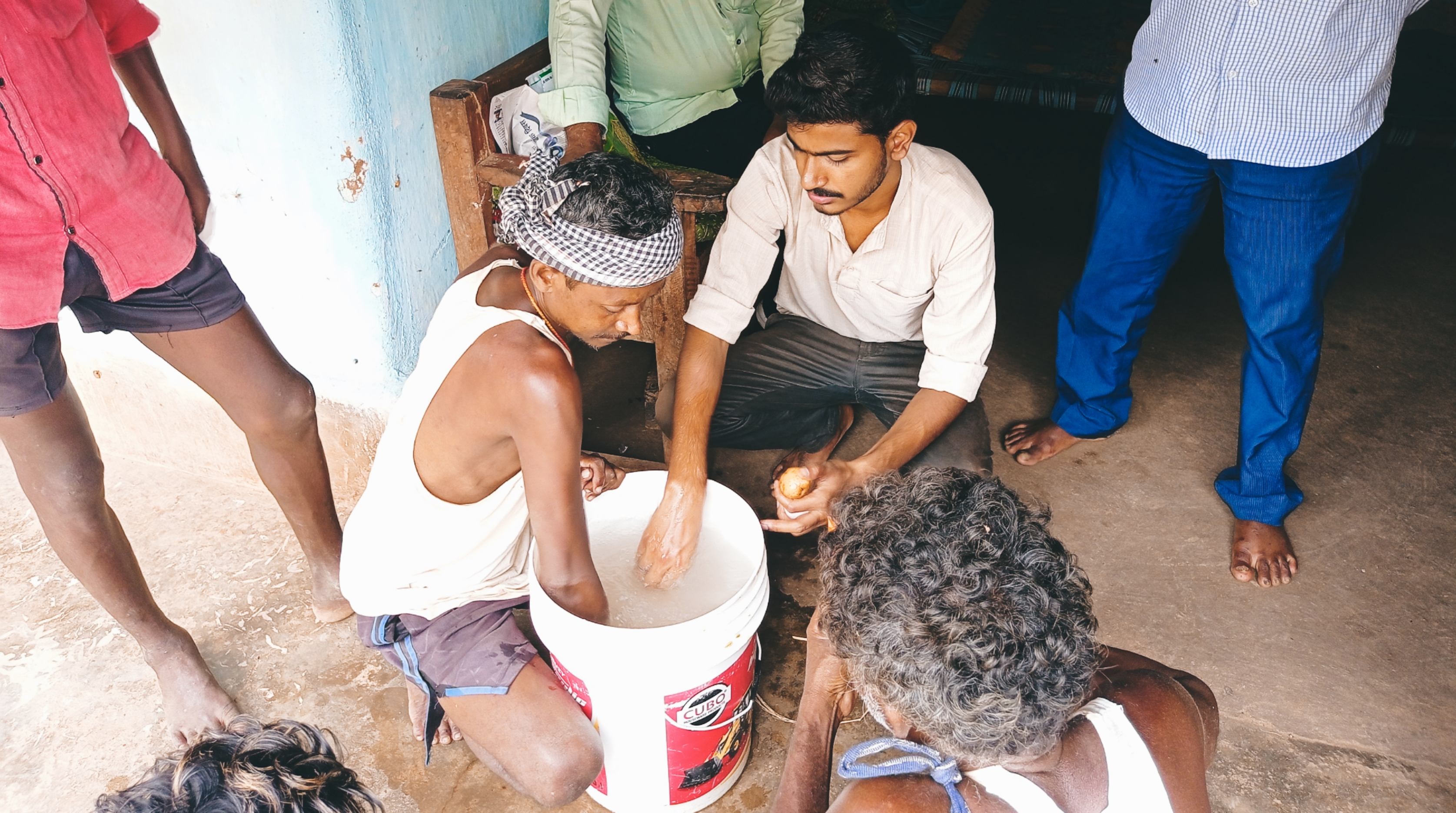
Demonstrating the seed treatment process to farmers in Sukurda village | Picture Courtesy: Gajendra Singh
I used to wait for Sundays earlier because that was my day off. Now I like to engage with the villagers even on holidays because a day without engagement sometimes feels like a void. Earlier, I would complain about my work to my family or friends; now I call them and tell them the story of our villages, put photos on social media of the paddy fields and even make mud pots.
I would often wonder earlier as to why my team-mates would talk incessantly about Federation-vali didi: in fact, I would get bored by those conversations. Now, my discussions with my fellow DAs are mostly on the lines of “Tune DSR lagaya hai ya SRI (Have you done DSR or SRI?)?” From wanting to go to a fancy hotel with friends to deciding to spend days in those beautiful mud coated houses, I have seen the change in myself as a person. The older me would never have imagined that I would one day start craving for maduwa roti instead of for KFC chicken wings!
Peeling an onion: A little philosophy
The process of change is like an onion, with its multiple layers. The more one peels it, the more one is likely to start crying. Let’s say the first layer of this onion is simple understanding of one’s emotions. “This is when I feel happy.” “This makes me feel sad.” “This gives me hope.” The second layer is to ask why we feel certain emotions. Such questions are important because they illuminate what we consider right or wrong. The third and the deeper layer is our personal values: Why do I consider this to be right/wrong? How am I choosing to measure myself? By what standards am I judging myself and everyone around me? This has been my approach during my DA-ship and this is what brings change inside me; I consider this change to be the most beautiful outcome for me. Yes, I won’t deny the fact that it has not been roses throughout my journey because some days were exhausting and some (the initial days) were intense enough to make me cry. I failed at so many things because I tried so many things. And what I’ve learnt is that I have to be willing to fall down, get up, look stupid, cry, laugh, make a mess, clean it up and not stop until you get there. No matter what.
During my 11-month DA-ship period in PRADAN, I became a farmer, a school teacher, an SHG auditor, a MGNREGA worker, a goatherd and a thousand other things…and yet I remain myself—Shubhankan. I am never more myself than when I do each of these things. I have come a long way and there is a long way ahead that beckons me in PRADAN. Regardless of my position and future in PRADAN, I am sure I will be with the community, having fun and changing their lives as well as mine.


11 Comments
“A great writer” I would like to start my comment with the quoted sentence as I’m asked to leave a comment in the box.
Through out the entire writing you were sufficiently able to reflect your journey, attitude, learnings, challenges, failures, achievements and I was swimming in my village stay, village study days and learning by doing phases thinking, what a great opportunity this is (DAship, PRADAN) to explore the life and development of self and our surrounding as well.
Looking forward to your next writing ✍️👍.
Thank you Siddhant
Very interesting and thought provoking article. Wishing you good luck!
Thank you Suhasini.
Hi Shubhankan! I loved your piece here. It was so engaging. I started reading it and found myself in your world going through your experiences. What a piece! It must have required a lot of courage for you to write about your culture, your learning and your struggles. You spoke out loud about your traditions, culture, critiquing them and exploring the other world. Very enriching experience. The relations you built between the events happening around you were beautifully weaved together.
Flow of the writing was so engaging I got so engrossed while reading it. I wish to congratulate you for this beautiful writing of yours. And I wish all the best for your future ahead. Wherever you will be I am sure you will be enlightening the path ahead.
Thank You Sushmita
Hi Shubhankan ! I loved your piece here. It was so engaging. I started reading it and found myself in your world going through your experiences. What a piece! It must have required a lot of courage for you to write about your culture, your learning and your struggles. You spoke out loud about your traditions, culture, critiquing them and exploring the other world. Very enriching experience. The relations you built between the events happening around you were beautifully weaved together.
Flow of the writing was so engaging I got so engrossed while reading it. I wish to congratulate you for this beautiful writing of yours. And I wish all the best for your future ahead. Wherever you will be I am sure you will be enlightening the path ahead.
Amazing articulation of your connects!
Thank you Anita
Well expressed.
Keep up the good work so that more people get motivated and inspired from you. Looking forward to your next article. 🌟
Thanks Priyanka